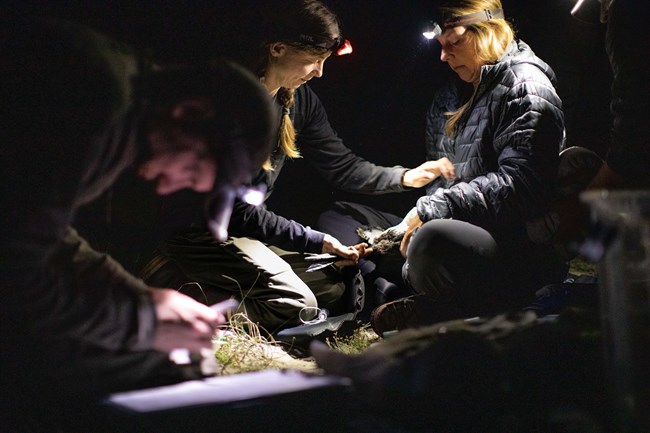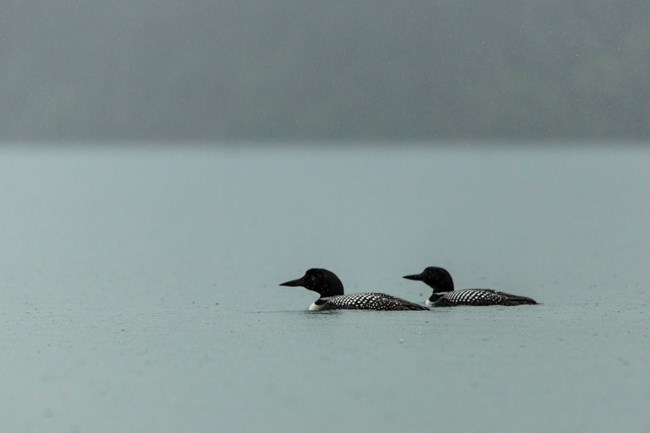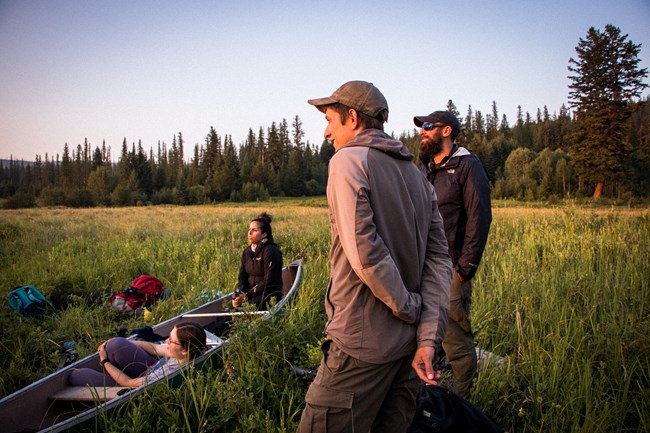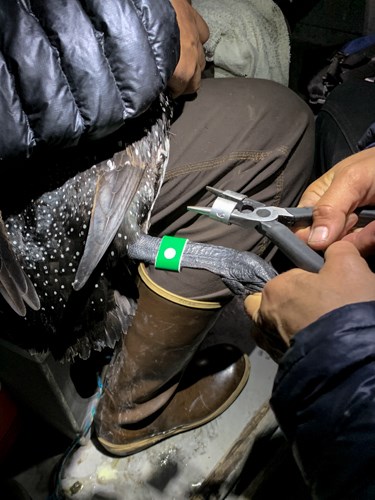Last updated: June 6, 2022
Article
Midnight Banders
By Renata Harrison

NPS/Renata Harrison
Headlamp beams slice through the dark, revealing a flurry of movement. The team around me moves with a quiet intensity, handing off tools like surgeons. They’ve covered the head of their subject in a white towel. One person holds the bird on their lap, stabilizing its head in the crook of their elbow. A long, needlepoint beak pokes through the cloth. The towel slips for a moment, and I see soft black nostrils open and close. The loon breathes with a soft, heavy sigh.
Growing up, I spent summers at a family cabin on a lake in eastern Ontario. Loons were a part of everyday life there–they sang us to sleep and wailed us awake. My family and I even held competitions to see who could imitate them best. When I came to Glacier to work for the Crown of the Continent Research Learning Center (CCRLC), I was glad to learn there was a citizen science project that monitored Common Loons, but I didn’t really understand why. I assumed loons were as common here as in Ontario.
It turns out that in Montana, loons are on the southern edge of a shrunken range. There are 72 pairs of breeding loons in the state, the highest number of loons west of the Mississippi. Compared to Ontario’s 97,000 breeding pairs, that number seems tiny. Although loon populations are currently stable in most of their breeding range, their future is in question. Habitat loss and human disturbance have pushed them to the northernmost parts of the country. Under a climate change scenario where the Earth’s average temperature increases 3°C by 2080, loons would likely disappear from the contiguous United States.

NPS Photo
This summer, the CCRLC’s biologist and Citizen Science Program Coordinator Jami Belt worked with partners from the Common Loon Working Group to band loons on lakes in and around the park. I was lucky enough to tag along to learn about the process and document it for our Glacier Science Video Series and a short video called Midnight Banders (below).
To capture loons at night, researchers use three essential tools: a spotlight, a dip net, and their mouths. The spotlight is for locating and temporarily stunning the bird. While the bird is transfixed, another person scoops it up with the dip net. The loon is initially drawn to the boat by researchers who skillfully imitate the soft, whistle-like calls of loon chicks. Banding happens only after chicks are hatched to avoid disturbing loons on their nest sites.

NPS/Renata Harrison
Standing on the shore, watching and waiting, I experienced the strange thrill of being awake all night, outside. Watching the banders out on the canoe, I marveled at the fact that they were doing this for seven nights in a row, for the second time this summer. The beam of their spotlight swept across the lake, catching me mid-thought, freezing me for an instant in this strange place and time. Finally, they stopped on something. A loon floated, transfixed in the light. I heard the net go in the water. I squinted into the dark, waiting for the visual cue of a successful capture—the canoe headed back to shore—but, no such luck. For hours, this pattern continued…the soft whistling, the flashes of light, the splash and dunk of loons escaping the net yet again.
On the second night, we were determined to outsmart the loons. We left early, reaching our lake well before dark, then hiked up a steep hillside to hide ourselves out of view. We waited out the mosquitoes. We waited out the moonrise. Around 1:00 a.m., using only the red lights of our headlamps, we started creeping down the hill. Instantly, the loons began alarm calling, their cries ringing through the dark. You can probably guess how the rest of that night went.

NPS/Katherine Barrs
Banding is a way to individually mark birds in a way that allows visual identification from a distance. It allows researchers to look at survival, turnover of territories, and dispersal—where young loons strike out to find their own lakes. In Northwest Montana where the state’s population of breeding loons are concentrated, an average of about 40 chicks hatch each summer. In Glacier, a heavily protected, million-acre national park, only six to eight chicks make it each year. We’re counting on each of those tiny chicks to persist and carry the population forward. In addition to banding, researchers take body measurements and feather and blood samples that are used to test for mercury, an environmental pollutant that can kill loons.
Back on the shore, Jami and her colleagues crouch over the loon, intensely focused. They don’t want to handle the bird any longer than necessary. Time slows and bends as I take in the presence of this creature I thought I knew…the size of it, the incredible beauty of its feathers, its obvious strength. Its breath, rising and falling, sounds strikingly human. After the measurements and samples are completed, they release the loon carefully back into the water. It pauses, a bit stunned, then sculls out into the shadows. The team resets and readies to go out again, spurred on by success. Before the night is over, we’ll go to a second lake and capture three more birds. Tomorrow, these loon wranglers will do it all again. I’m floored by the work ethic and dedication of these biologists. I’m in awe of the loon’s tenacity; clinging to the southern edge of its range. And I know, in this moment, that I'll never again take them for granted.
- Duration:
- 3 minutes, 35 seconds
Join us on a nighttime adventure to see how researchers capture and band Common Loons on lakes in and around the park. Since the early 2000s, researchers from the Common Loon Working Group have captured loons and fit them with identifying leg bands to better understand the status of Common Loons in Montana. Because there are so few breeding pairs in the state (about 60-70), every bird’s life history holds precious clues.
